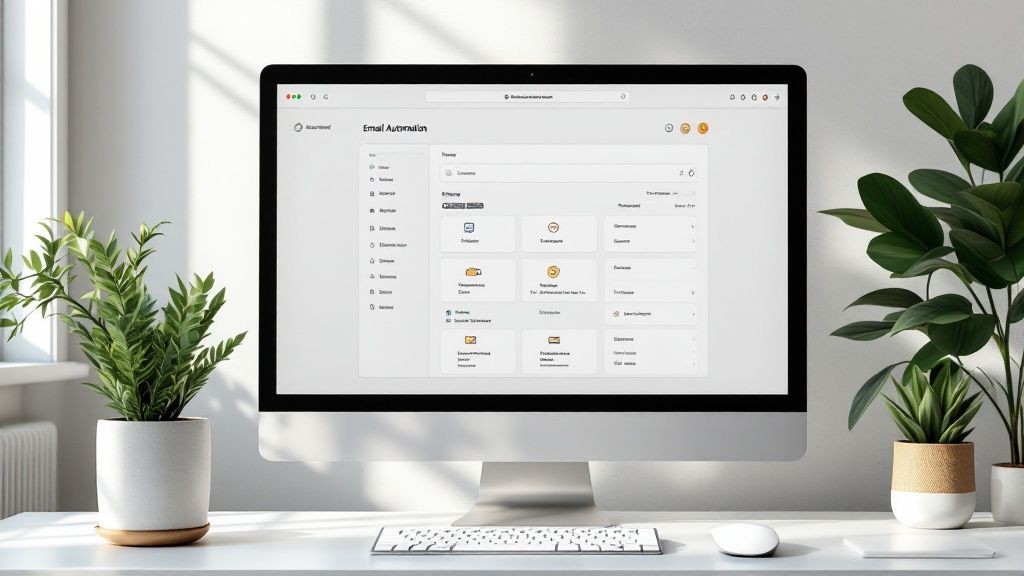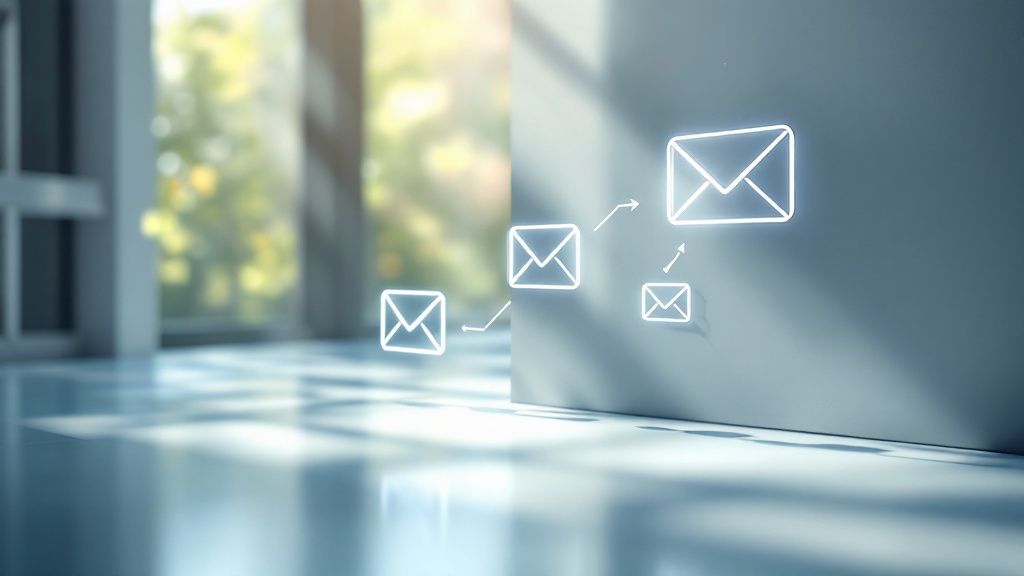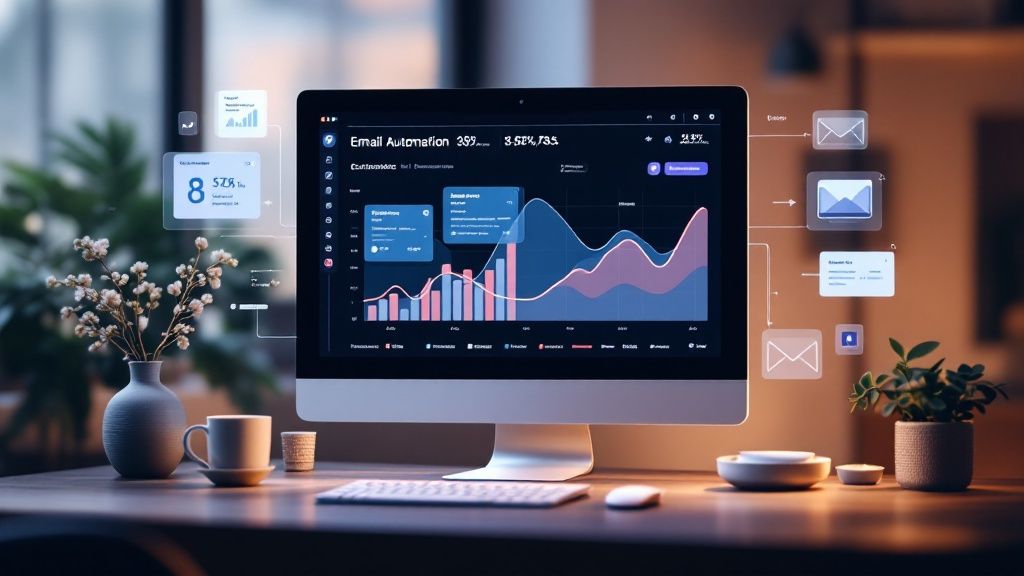Email Automation for Ecommerce: Boost Conversions
April 21, 2025

The Real Impact of Email Automation on Ecommerce Success

Email automation is more than just sending bulk emails. It's about crafting personalized experiences that resonate with each customer. This targeted approach builds genuine engagement, changing how e-commerce businesses connect with their audience. Instead of generic promotions, automated emails can offer product recommendations based on individual browsing history or past purchases.
This shift toward personalized communication cultivates stronger customer relationships and ultimately drives conversions. A well-timed, relevant message can be significantly more effective than a frequent, generic one.
Moving Beyond Mass Emailing
Effective email automation uses behavioral triggers to deliver the right message at the right time. Imagine walking into a store and having a sales associate greet you, offering assistance based on the items you're looking at. Email automation, when done well, replicates this experience online.
This approach helps businesses create personalized communications that feel more like one-on-one conversations. It moves away from impersonal blasts and toward solving specific needs and fostering stronger relationships. This doesn't have to be complex; even simple touches like using a customer's name or referencing a previous purchase can create a much stronger connection.
The Power of Personalized Timing
Timing is everything in email automation. A welcome email sent immediately after signup makes a new subscriber feel valued. A strategically timed abandoned cart email can recover a lost sale. These targeted messages demonstrate care and attention that resonate with customers.
Email automation in e-commerce has proven remarkably effective in driving customer engagement. The first email in an automated sequence can achieve an open rate as high as 64.03% and a click-through rate of 21.32%. Overall open and click rates for automated emails are 47.82% and 16.88%, respectively. This demonstrates their potential to boost sales. Find more detailed statistics here: Explore email automation stats. Successful brands also leverage post-purchase sequences to nurture customers and encourage repeat business.
Focusing on Solutions, Not Just Promotions
The best email automations focus on addressing customer needs and solving their problems, not just promoting products. A post-purchase email could offer tips on using a recently purchased item. A browse abandonment email could showcase similar products a customer might be interested in.
By providing value beyond sales pitches, businesses build trust and loyalty. This approach positions the brand as a helpful resource, fostering a sense of community and increasing customer lifetime value. This ultimately leads to more sustainable growth and stronger customer relationships.
Revenue-Driving Sequences Every Ecommerce Store Needs

While a welcome email series is a great start to email automation for ecommerce, truly successful stores extend their strategies beyond this initial step. These stores recognize the need for diverse automated workflows, or sequences, to effectively guide customers through the sales funnel. This involves crafting targeted messages that connect with customers at each stage of their buying journey.
Abandoned Cart Recovery
One of the most impactful email automation sequences is the abandoned cart email. This sequence specifically targets customers who add items to their shopping cart but leave the website before completing the purchase. A carefully designed abandoned cart sequence can recover these potentially lost sales by subtly reminding customers about the items they've selected.
Offering incentives, such as free shipping or a small discount, can further encourage the customer to complete the purchase. Finding the right balance between persistence and a respectful, non-intrusive approach is key to success with this sequence.
For example, a clothing retailer might implement a three-email abandoned cart sequence. The first email, sent one hour after cart abandonment, serves as a simple reminder. The second email, sent 24 hours later, could highlight the benefits of the specific items left behind. The final email, sent after 72 hours, might offer a time-sensitive discount.
Post-Purchase Engagement
The opportunity to connect with customers through email automation extends beyond the initial purchase. Post-purchase sequences are essential for cultivating customer loyalty and encouraging repeat business. These emails can include order confirmations, shipping updates, and product care instructions.
This is also an excellent time to introduce complementary products or cross-sell related items based on the customer's original purchase. For instance, if a customer purchases a new camera, a post-purchase sequence could recommend lenses, tripods, or camera bags. This personalized approach provides valuable suggestions while also increasing the customer's lifetime value.
Browse Abandonment Emails
Another effective sequence is the browse abandonment email. This sequence targets customers who view specific products on your website but don't add them to their cart. These emails should be helpful, not intrusive, showcasing the browsed items and highlighting their key features and benefits.
Including social proof, such as positive customer reviews, can build trust and further encourage a purchase. This gentle nudge can be highly effective in reminding customers of their initial interest and assisting them in making an informed buying decision. It also presents another opportunity for personalized recommendations based on browsing history.
To illustrate how these email sequences fit into the customer journey and perform, let's take a look at the following table:
Key Ecommerce Email Automation Sequences
| Sequence Type | Typical Open Rate | Average Conversion Rate | Best Timing | Key Components |
|---|---|---|---|---|
| Abandoned Cart | 40-50% | 2-5% | 1 hour, 24 hours, 72 hours after abandonment | Reminder, product benefits, discount offer |
| Post-Purchase | 30-40% | 1-2% | Immediately after purchase, then as needed | Order confirmation, shipping updates, product care, cross-sells |
| Browse Abandonment | 20-30% | 0.5-1% | A few hours after browsing | Product showcase, features, benefits, social proof |
| Welcome Series | 50-60% | Varies | Immediately after signup | Introduction, brand story, special offers |
| Win-Back | 42.51% | 10.34% | After a period of inactivity | Exclusive discounts, new arrivals |
This table summarizes the average performance and key elements of essential automated email sequences. Remember, these figures can vary depending on factors such as industry, target audience, and email design.
Win-Back Campaigns and ROI
Beyond these core sequences, email automation excels at re-engaging inactive customers. Win-back emails offer exclusive discounts or highlight new arrivals to entice lapsed customers to return. Automated email marketing isn’t just efficient; it's also highly profitable. Win-back emails, for example, have an open rate of 42.51%, a click-through rate of 18.27%, and a conversion rate of 10.34%, effectively re-engaging inactive customers.
Email marketing, in general, boasts a substantial return on investment (ROI). On average, it generates $40 for every dollar spent, resulting in an impressive 3900% ROI. This highlights the essential role email automation plays in customer retention and revenue growth. Discover more insights about email marketing ROI. Platforms like Checkout Links can streamline the creation and management of these revenue-generating sequences, optimizing email automation and driving conversions with seamless Shopify integration and personalized link creation.
Personalization That Converts (Not Just Creeps Out)

Simply adding a customer's first name to an email isn't enough anymore. Today's consumers expect personalized experiences that are both relevant and respectful. This requires a careful balance, avoiding intrusive tactics that damage trust while creating genuinely helpful interactions. This section explores how to achieve this delicate equilibrium.
Segmentation Beyond the Basics
Segmentation is the foundation of effective personalization. While basic demographics like age, gender, and location can be a starting point, it's essential to delve deeper.
Behavioral data offers richer insights. This includes past purchases, browsing history, and website interactions. By segmenting based on these behaviors, you can tailor messaging to reflect individual customer interests and needs.
For example, instead of a generic "new arrivals" email, create targeted campaigns for specific product categories. Customers who frequently buy athletic wear will receive different recommendations than those interested in home decor. This targeted approach boosts relevance and effectiveness. For more practical examples, check out this article on ecommerce personalization examples.
Dynamic Content for Personalized Experiences
Dynamic content elevates personalization. It automatically adapts based on predefined rules and customer data. A single email template can display different products, promotions, or messaging based on the recipient.
Consider an abandoned cart email. With dynamic content, it can display the specific items left behind, along with relevant accessories. This personalized reminder can significantly improve conversion rates. This tactic also works well for product recommendations in email newsletters or post-purchase follow-ups.
Respectful Product Recommendations That Resonate
Personalized product recommendations are only effective when they truly resonate. Random suggestions can erode customer trust and decrease engagement. Focus on recommendations based on browsing history, past purchases, or complementary items.
For instance, if a customer recently bought a coffee maker, they might be interested in coffee filters or beans. Recommending gardening tools would be irrelevant and potentially annoying. Targeted, helpful recommendations build trust and encourage repeat business. The strategic use of AI-driven personalization is predicted to heavily influence email automation in e-commerce. Recent surveys show that roughly 39% of email marketing professionals expect AI-driven hyper-personalization to significantly impact email automation campaigns. This highlights the increasing importance of using technology to personalize communications. With global email users expected to reach 4.89 billion by 2027, the potential for personalized automated emails to boost engagement and conversion rates is enormous. This underscores the evolution of email marketing, where advanced personalization will likely be crucial for success. For further insights, explore these email marketing statistics.
Avoiding Personalization Pitfalls
While powerful, personalization can be intrusive if not handled carefully. Overly personalized emails can feel creepy and damage trust. Avoid using highly sensitive information or making assumptions about customers' private lives.
Concentrate on providing value and helpful recommendations, rather than overwhelming customers with excessive personalization. The right balance enables you to build strong customer relationships and drive conversions through email automation for ecommerce without compromising privacy or trust.
Selecting Your Email Automation Platform Without Regrets

Choosing the right email automation platform is crucial for ecommerce success. The wrong platform can lead to wasted time and resources, hindering your ability to connect with customers effectively. This section explores the key factors to consider when making this critical decision.
Essential Integration Capabilities
Seamless integration with your existing ecommerce platform is paramount. Your email automation platform should connect effortlessly with your online store, your Customer Relationship Management (CRM) system, and other essential tools. This prevents data silos and ensures smooth customer data flow between systems.
This unified view of your customer is essential for personalized messaging and effective segmentation. For example, integrating your platform with your Shopify store allows automatic abandoned cart emails based on real-time activity. This timely intervention can significantly improve cart recovery rates. Check out our guide on How to master email marketing automation best practices.
Template Flexibility and Brand Consistency
Maintaining consistent brand identity across all customer touchpoints is essential. Your email automation platform should offer flexible templates easily customized to your brand's visual style. This includes incorporating your logo, brand colors, and preferred fonts.
This cohesive branding reinforces your brand identity and strengthens customer recognition. Beyond aesthetics, template flexibility lets you adapt quickly to changing marketing needs. You should easily create different email formats for various campaigns, from promotional announcements to personalized product recommendations.
Analytics and Optimization
Data-driven decision-making is key to email marketing success. Your chosen platform should provide detailed analytics beyond basic open and click-through rates. This includes metrics like conversion rates, revenue generated, and customer lifetime value.
This granular data empowers you to identify what's working and what needs improvement. You can then optimize your email sequences and personalize messages based on actionable insights.
Scalability for Future Growth
Choosing a platform that scales with your business is essential. As your ecommerce store grows, your email automation needs will evolve. Your platform should handle increasing email volumes and more complex automation workflows.
Migrating to a new platform can be time-consuming and costly, so selecting a scalable solution from the start is a wise investment.
Balancing Immediate Needs With Long-Term Vision
While considering long-term scalability is crucial, you also need to address your immediate needs. Assess your current email marketing objectives and choose a platform offering the features you require today. This might include specific automation workflows, integration capabilities, or reporting functionalities.
Finding the right balance between present needs and future growth is key to selecting the best email automation platform for your business. For more information, see our guide on How to master email marketing automation best practices.
To help you compare different platforms, we've compiled the following table:
The table below provides a detailed comparison of popular email automation platforms tailored for ecommerce businesses. It highlights key features, integrations, and pricing considerations to help you make an informed decision.
Ecommerce Email Automation Platform Comparison:
| Platform | Best For | Ecommerce Integrations | Automation Features | Pricing Model | Limitations |
|---|---|---|---|---|---|
| Klaviyo | Businesses focused on personalized email marketing | Shopify, Magento, BigCommerce | Abandoned cart emails, segmented campaigns, personalized product recommendations | Tiered based on number of contacts | Can be expensive for large contact lists |
| Omnisend | Omnichannel marketing automation | Shopify, BigCommerce, WooCommerce | Email, SMS, push notifications, pop-ups | Tiered based on number of contacts and features | Limited integrations outside of major ecommerce platforms |
| Mailchimp | Small to medium-sized businesses | Shopify, WooCommerce, Square | Basic email automation, landing pages, social media ads | Free and paid plans based on features and contacts | Automation features are limited in the free plan |
| ActiveCampaign | Businesses focused on sales and CRM | Shopify, WooCommerce, Salesforce | Advanced automation workflows, CRM features, sales automation | Tiered based on number of contacts and features | Can be complex to set up and manage |
| Constant Contact | Small businesses and nonprofits | Shopify, WooCommerce, Eventbrite | Email marketing, event marketing, surveys | Tiered based on number of contacts | Limited automation features compared to other platforms |
This comparison highlights the diverse landscape of email automation platforms. Choosing the best one depends on your specific needs, budget, and technical expertise. Carefully consider the factors discussed to ensure a successful email marketing strategy.
Measuring What Matters: Beyond Opens and Clicks
Open and click-through rates offer a glimpse into email engagement, but they only scratch the surface, especially for ecommerce businesses. Focusing solely on these vanity metrics can obscure the true drivers of email automation success: revenue and customer lifetime value. This section explores the metrics that truly impact your bottom line and how to leverage them to optimize your email automation strategy.
Accurately Attributing Revenue Across Complex Customer Journeys
Customers rarely convert after a single email. Their journey often involves multiple touchpoints, from abandoned cart emails to promotional campaigns, before making a purchase. Understanding which of these touchpoints are actually driving sales requires accurate revenue attribution.
UTM tracking for email campaigns provides granular data on which links are converting best. Tools like Checkout Links offer this functionality, allowing you to pinpoint the most effective email sequences and refine your strategy accordingly. This provides valuable data on actual conversions, going beyond simple click-through rates.
Establishing Realistic Benchmarks
While industry benchmarks offer a helpful starting point, your target metrics should reflect your specific industry, audience, and product type. For example, a luxury brand might see lower conversion rates but higher average order values than a budget retailer.
The timing of your email sequences also plays a role. A welcome email sent immediately after signup will likely have a higher open rate than a browse abandonment email sent hours later. Understanding these nuances helps you set realistic goals and accurately measure your progress.
Identifying and Addressing Sequence Fatigue
Even high-performing automated email sequences can lose their impact over time due to sequence fatigue. This occurs when subscribers become less responsive to your emails, resulting in lower open rates, click-through rates, and conversions.
Regularly monitoring your email automation performance for declining engagement or increasing unsubscribe rates is crucial. A/B testing different subject lines, content, or sending frequencies can help re-engage your audience and prevent performance decline.
A/B Testing for Actionable Insights
A/B testing is a powerful tool for email automation optimization. However, testing without a clear hypothesis can create statistical noise rather than useful data. Focus on specific areas for improvement instead of randomly testing elements.
For example, if your abandoned cart sequence has a low conversion rate, test different discount offers, subject lines, or email timing. Analyzing the results of these targeted tests yields actionable insights that can guide your optimization efforts.
Iteration Over Overhaul
Constantly revamping your email automation strategy can be counterproductive. A more effective approach is strategic iteration. Continuously analyze your results, identify areas for improvement, and make small, data-driven changes.
This systematic approach allows you to fine-tune your automations over time, leading to consistent growth. By focusing on key metrics and iterating based on data, you can build a sustainable and successful email automation strategy for your ecommerce business.
Orchestrating the Complete Customer Experience
Email automation for ecommerce isn't a standalone tactic. It's most effective as a key component of a larger, interconnected marketing strategy. Successful ecommerce brands recognize the value of creating seamless experiences across multiple channels. This exploration delves into how to integrate your email automation with other marketing efforts, building a cohesive and effective customer journey.
Connecting Email With Other Channels
Visualize your customer journey as a symphony. Each marketing channel plays a distinct instrument. Email automation acts as the conductor, orchestrating these different instruments into a harmonious whole. Integrating email with social media, paid advertising, SMS messaging, and on-site experiences amplifies your message and connects with customers where they're most engaged.
Imagine a customer abandoning their cart on your website. An automated email reminds them of the items left behind. At the same time, a targeted ad showcasing those same products appears in their social media feed. This coordinated approach reinforces the message and boosts the chance of a conversion.
Cross-Channel Workflows That Convert
Building effective cross-channel workflows depends on understanding your customer's behavior and preferences. Data is essential for identifying the most valuable integration points. Here are a few practical examples:
-
Social Media & Email: After a customer completes a purchase, an automated email confirms their order and invites them to follow your brand on social media for exclusive updates and promotions.
-
Paid Advertising & Email: Segment your email list according to purchase history. Use these segments to create tailored ad campaigns on platforms like Google Ads and Facebook Ads, showing specific product recommendations or exclusive discounts.
-
SMS & Email: Send time-sensitive alerts like flash sales or shipping updates via SMS. Follow up with a more detailed email containing additional information and related product suggestions.
-
On-Site Experiences & Email: Track website activity to initiate personalized emails. If a customer views a specific product category multiple times, send an email showcasing relevant items and offering a small discount.
Reinforcing, Not Fragmenting, Customer Relationships
The objective of cross-channel integration is to craft a consistent and relevant experience across every touchpoint. Each interaction should reinforce your brand message and cultivate stronger customer relationships.
However, poorly planned integration can backfire, resulting in fragmented and confusing experiences. Avoid overwhelming customers with redundant or irrelevant messages across different channels.
Instead, concentrate on building a cohesive narrative that guides the customer through their buying journey. By strategically integrating email automation with other marketing initiatives, you can create a personalized and impactful experience that drives conversions and encourages long-term loyalty. This orchestrated strategy turns individual marketing channels into a powerful, unified force.
Start optimizing your email automation for ecommerce today. Checkout Links empowers Shopify merchants to create personalized, shoppable links that seamlessly integrate with email marketing campaigns and automated triggers to recover abandoned carts and boost conversions, taking your email automation to the next level.
 Checkout Links
Checkout Links



